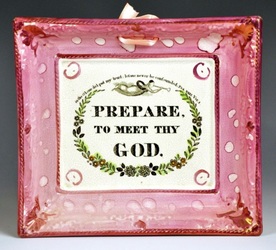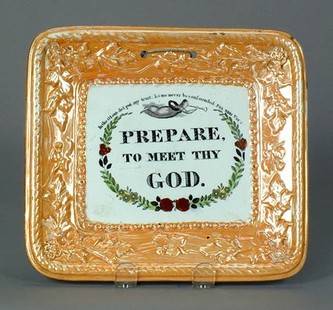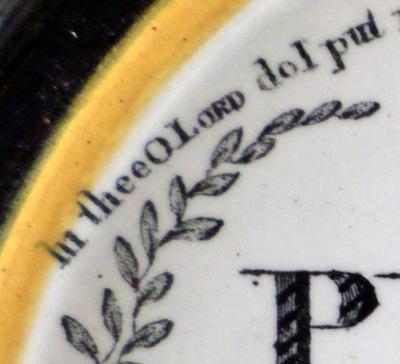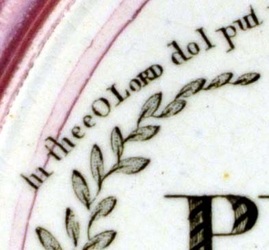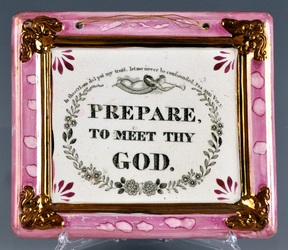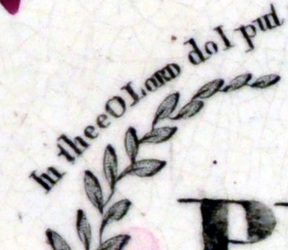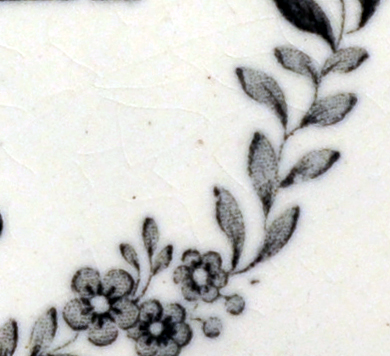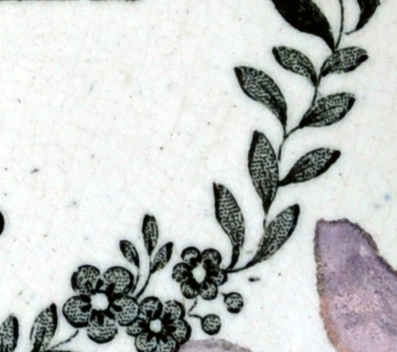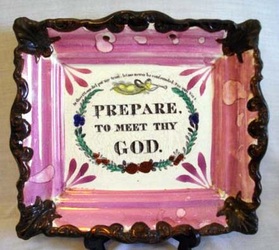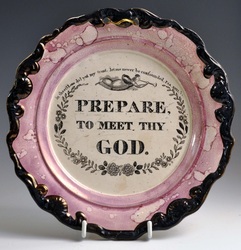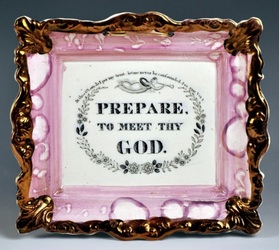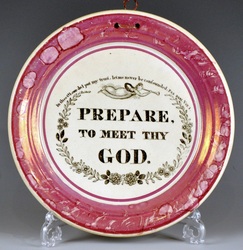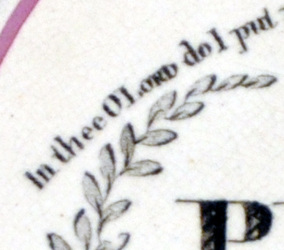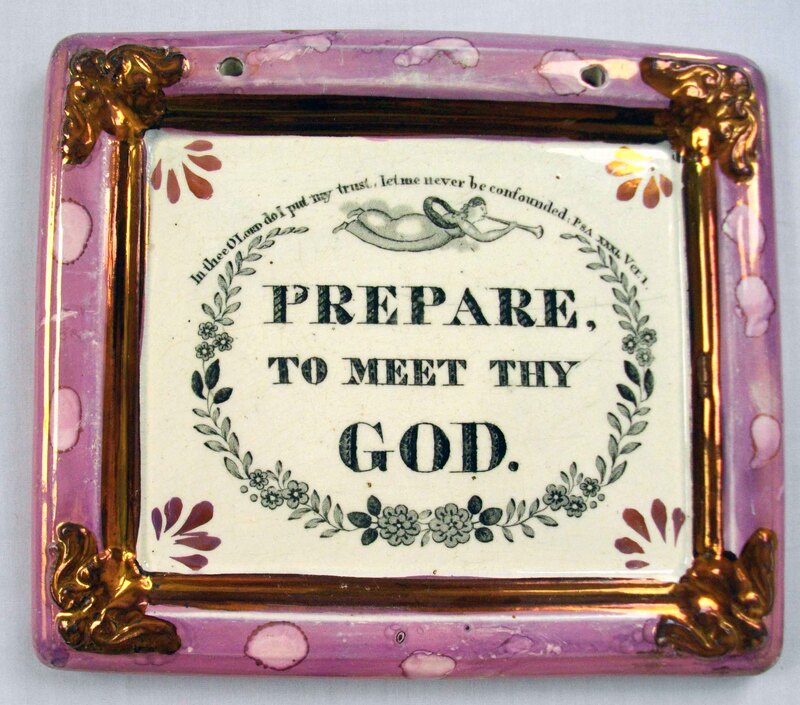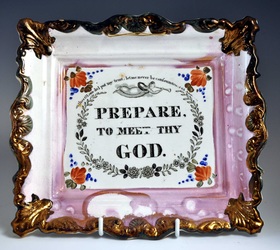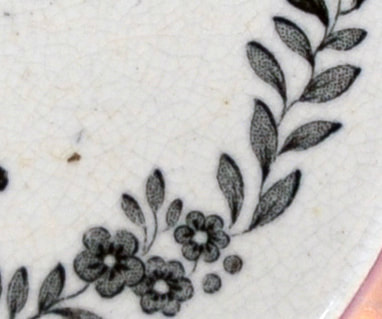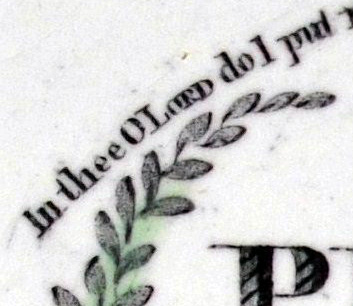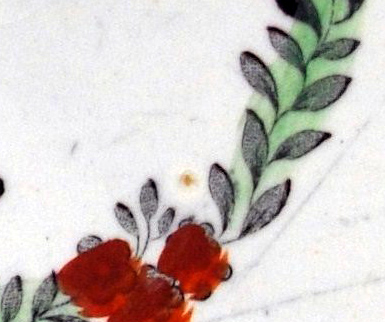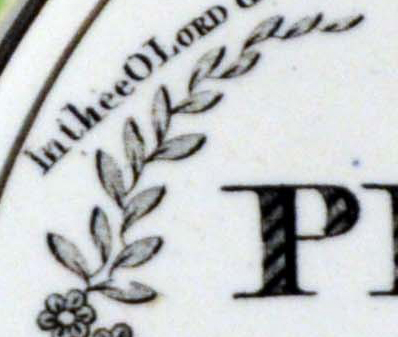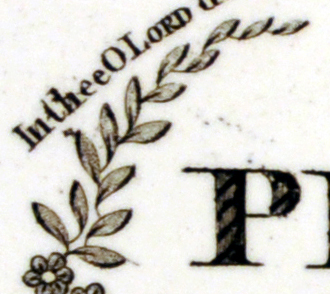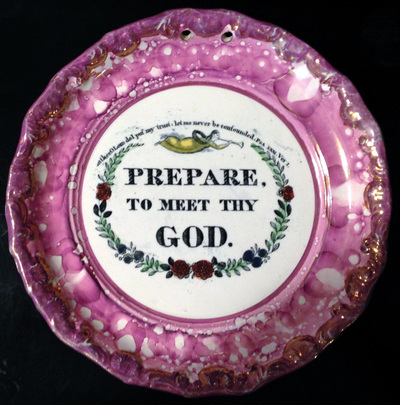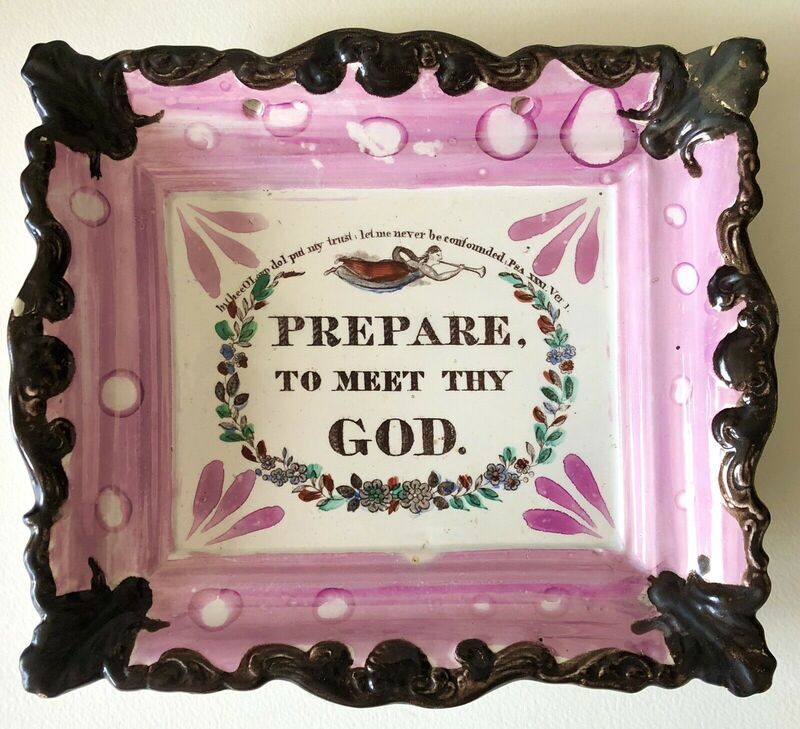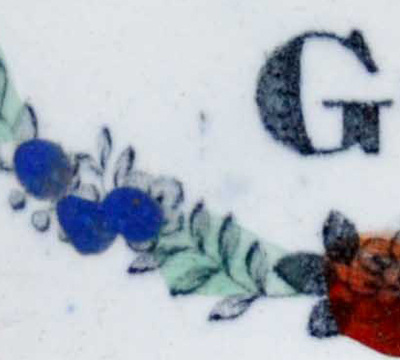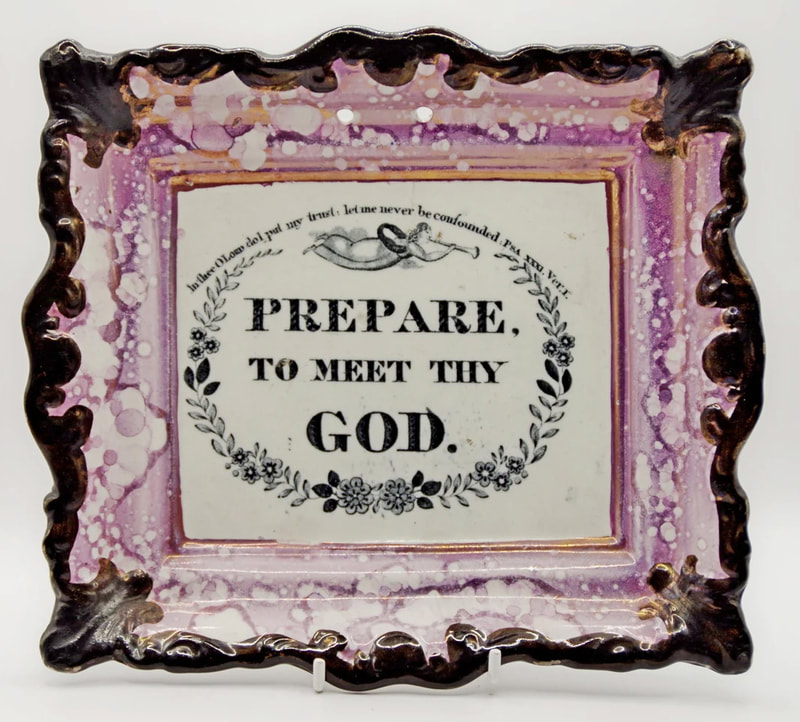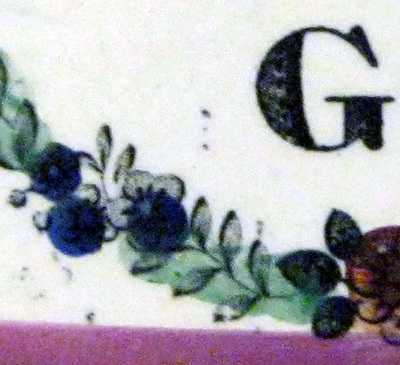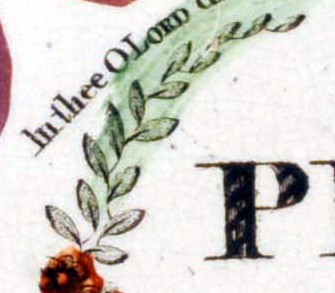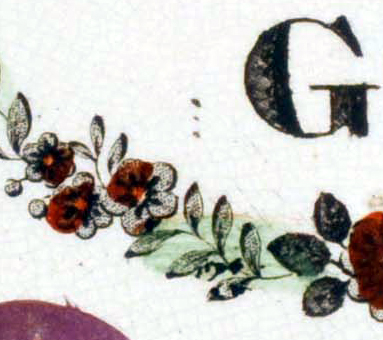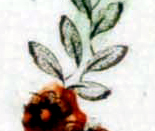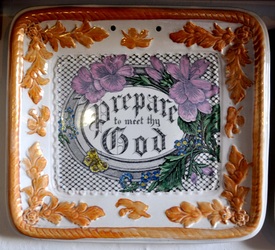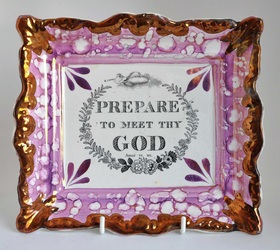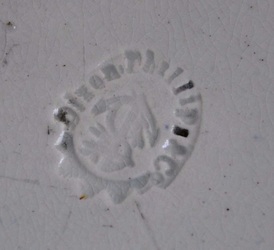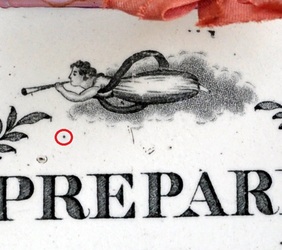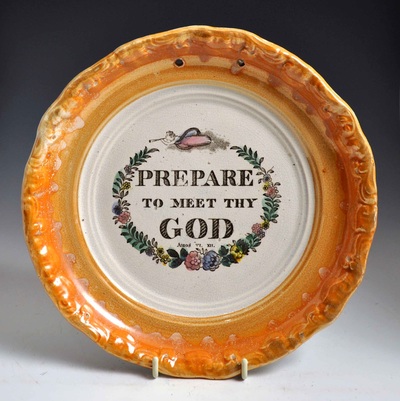Prepare to meet thy god - page 1
For an overview of pink lustre plaques with religious subjects, click on the Religious heading above. I've split the 'Prepare to meet thy god' transfers into two pages. Page 1: Wearside potteries, e.g. Scott, Newbottle, Moore, and Dixon. Page 2: Tyneside and other potteries, e.g. C., C. & Co, Carr, Maling, Stockton.
'Prepare to meet thy god' is the most common verse found on plaques. Click on the Maling plaques and Dixon plaques pages to see some early examples, which are outside the scope of these pages.
The earliest plaques tend to be circular (though Maling also made small rectangular versions), and sometimes the text is hand painted. Cornfoot, Colville and Co, 1828–1832, made a transferred version with the verse 'In thee O Lord do I put my trust: let me never be Confounded: PSA: XXXI Vir. I.', above a trumpeting angel.
Sometime around 1840, an enterprising engraver appears to have copied the C., C. & Co design and made at least five, almost identical transfer plates, for various Sunderland potteries (Newbottle, Scott and Moore). The differences between the transfers, which I've labelled 'Sunderland plate 1', 'Sunderland plate 2', 'Sunderland plate 3', etc, are miniscule. Some of the Moore & Co transfers (plate 4) also appear on Scott-attributed items. We know that Scott sometimes supplied Moore with items for decoration (Baker).
Dixon, Phillips & Co, 1839-1865, were also prolific in their production of plaques with the text. In the Dixon versions, the angel flies in the opposite direction (i.e. facing left). Moore's appears to have purchased the Dixon transfer plates when the Garrison Pottery closed in 1865. The transfer plate was used well into the 1870s on orange lustre plaques, on forms associated with both Scott and Moore. Other factories copied the Dixon transfer. So at least two other versions with the angel facing left exist.
John Carr used the text under an all-seeing eye on later plaques, c1850s–70s.
It is possible that Ball's Deptford Pottery continued production of this verse right into the 20th century, on orange-bordered plaques.
'Prepare to meet thy god' is the most common verse found on plaques. Click on the Maling plaques and Dixon plaques pages to see some early examples, which are outside the scope of these pages.
The earliest plaques tend to be circular (though Maling also made small rectangular versions), and sometimes the text is hand painted. Cornfoot, Colville and Co, 1828–1832, made a transferred version with the verse 'In thee O Lord do I put my trust: let me never be Confounded: PSA: XXXI Vir. I.', above a trumpeting angel.
Sometime around 1840, an enterprising engraver appears to have copied the C., C. & Co design and made at least five, almost identical transfer plates, for various Sunderland potteries (Newbottle, Scott and Moore). The differences between the transfers, which I've labelled 'Sunderland plate 1', 'Sunderland plate 2', 'Sunderland plate 3', etc, are miniscule. Some of the Moore & Co transfers (plate 4) also appear on Scott-attributed items. We know that Scott sometimes supplied Moore with items for decoration (Baker).
Dixon, Phillips & Co, 1839-1865, were also prolific in their production of plaques with the text. In the Dixon versions, the angel flies in the opposite direction (i.e. facing left). Moore's appears to have purchased the Dixon transfer plates when the Garrison Pottery closed in 1865. The transfer plate was used well into the 1870s on orange lustre plaques, on forms associated with both Scott and Moore. Other factories copied the Dixon transfer. So at least two other versions with the angel facing left exist.
John Carr used the text under an all-seeing eye on later plaques, c1850s–70s.
It is possible that Ball's Deptford Pottery continued production of this verse right into the 20th century, on orange-bordered plaques.
Attributed to Scott of Southwick (Sunderland plate 1)
None of the above plaques has an impressed mark. They are attributed to Southwick on the basis that the Wesley transfer associated with Scott appears on most of these plaque forms. The first two plaques are small and fine, and have a chamfered edge on their rear side. All the plaques above share the same transfer which has an easily distinguishable fault. Instead of the verse at the top reading 'In thee O Lord...', it begins 'In the O Lord...' (see top left detail). The word 'PREPARE' is diagonally shaded. Whereas the words 'TO MEET THY GOD', are picked out with a single row of pips (see top centre detail). The first two plaques could be as early as c1830, and the last plaque as late as c1870.
Dimensions are as follows: top right, 170mm x 145mm; middle left, 167mm diameter; middle centre, 202mm x 212mm; middle right, bottom left and bottom centre, circa 225mm x 200mm; and bottom right, 222mm x 200mm.
The first three orange plaques below are also attributed to Scott, but likely c1870. These later plaques tend to be more heavily potted, and the quality of the transfer imprint poorer. They are about the same size as their pink equivalents above. The last plaque, with a faint transfer, is attributed to Ball's Deptford Pottery, c1900.
Dimensions are as follows: top right, 170mm x 145mm; middle left, 167mm diameter; middle centre, 202mm x 212mm; middle right, bottom left and bottom centre, circa 225mm x 200mm; and bottom right, 222mm x 200mm.
The first three orange plaques below are also attributed to Scott, but likely c1870. These later plaques tend to be more heavily potted, and the quality of the transfer imprint poorer. They are about the same size as their pink equivalents above. The last plaque, with a faint transfer, is attributed to Ball's Deptford Pottery, c1900.
Defining features
- The verse at the top reads 'In the O Lord...'
Attributed to Newbottle 'High' Pottery (Sunderland plate 2)
The black and yellow c1840 plaque above is unmarked, and attributed to Newbottle on the basis of its similarity to a 'Praise Ye the Lord' plaque presented to the V&A by descendents of the owners of the Newbottle 'High' Pottery. Click here to read more about the attribution. The pink-lustre plaque is thinner than its C C & Co counterpart. It has a chamfered edge to the rear,,, similar to those attributed to Scott's with the 'plate 1' transfer, but is larger in diameter (176mm, compared with 167mm). Also, the moulded border is wider, with more ridges.
The above plaques are likely later, c1845-60, and unmarked. They're attributed to Newbottle because they have the same transfer as the black and yellow plaque above. The first, third and last plaques are of a smaller rectangular form. The second, with copper lustre and white edges that can be seen from the front, has green corners. The bottom centre plaque is larger than the earlier circular plaques above, and again is chamfered on the back.
Note on the details in the third column of photos, in each case, the leaves on the left of the sprig are more heavily shaded on their left side. This transfer plate has an easily identifiable flaw – a small horizontal mark to the right of the third flower.
These plaque forms also appear with the 'plate 3' transfer (see next section below). So it looks as if Newbottle used 'plate 2' and 'plate 3' simultaneously between c1845-60.
The plaques below, from the 1860s, although again unmarked, are also attributed to Newbottle.
Note on the details in the third column of photos, in each case, the leaves on the left of the sprig are more heavily shaded on their left side. This transfer plate has an easily identifiable flaw – a small horizontal mark to the right of the third flower.
These plaque forms also appear with the 'plate 3' transfer (see next section below). So it looks as if Newbottle used 'plate 2' and 'plate 3' simultaneously between c1845-60.
The plaques below, from the 1860s, although again unmarked, are also attributed to Newbottle.
Defining features
- The verse at the top reads 'In thee O Lord...'
- The leaf under the 't' in 'thee' is more heavily shaded on the RIGHT side
- The circles to the right of the flowers ARE connected to the sprig by stalks
- The leaves in the bottom right corner, on the left of the sprig, are more heavily shaded on their LEFT side
- There is a small horizontal mark to the right of the third flower in the bottom right corner
Attributed to Newbottle 'High' Pottery (Sunderland plate 3)
The black and yellow c1830s plaque above is unmarked, and attributed to Newbottle on the basis of its similarity to a 'Praise Ye the Lord' plaque presented to the V&A by descendents of the owners of the Newbottle 'High' Pottery.
The above plaques, c1845–55, are from the same transfer plate as the plaque attributed to Newbottle 'High' Pottery. The enamel flower decoration on the first plaque is unique to this period, and doesn't appear to have been used on plaques by other potteries.
The verse at the top reads 'In thee O Lord...'. Note in the third column of photos, in each case, that the leaves on the left of the sprig are more heavily shaded on their right side. Note also, the two circles to the right of the flowers are not joined to the sprig by stalks.
The verse at the top reads 'In thee O Lord...'. Note in the third column of photos, in each case, that the leaves on the left of the sprig are more heavily shaded on their right side. Note also, the two circles to the right of the flowers are not joined to the sprig by stalks.
For a long while, I could find no evidence that this transfer was ever used on the later brown-bordered plaques of the 1860s. However, the plaques below share all of the features of the plate 3 transfer. But note, on the second plaque, the infill of the leaves in the right detail, made up of tiny, well-defined dots. This could be the result of the copper plate being re-engraved. The last plaque, without a lustre border, might be a factory second. All three plaques below have a small diagonal scratch or smudge to the right of the letter 'P' (see centre details). This does not appear on the plaques above.
Defining features
- The verse at the top reads 'In thee O Lord...'
- The leaf under the 't' in 'thee' is more heavily shaded on the RIGHT side
- The circles to the right of the flowers are NOT connected to the sprig by stalks
- The leaves in the bottom right corner, on the left of the sprig, are more heavily shaded on their RIGHT side
Attributed to Moore & Co, Wear Pottery, and Scott of Southwick
(Sunderland plate 4)
Though these plaques are unmarked, they are identical in form to others with Moore & Co impressed marks. The transfer, although almost identical to those attributed to Newbottle above, comes from a different transfer plate. Note that the leaf under the letter 't' in 'thee' is most heavily shaded on the left side.
The bowl above has a Scott impressed mark, and yet the Moore & Co 'Prepare' transfer. The transfer also rarely appears on plaques with brown borders from the 1860s, attributed to Moore's.
Defining features
- The verse at the top reads 'In thee O Lord...'
- The leaf under the 't' in 'thee' is more heavily shaded on the LEFT side
- The circles to the right of the flowers ARE connected to the sprig by stalks
- The leaves in the bottom right corner, on the left of the sprig, are more heavily shaded on their LEFT side
Attributed to Moore & Co, Wear Pottery (Sunderland plate 5)
Below is another group of plaques that I'd first thought came from the same transfer plate as plate 4 above. The leaves are all shaded on the same sides, the buds are connected to the flowers with stalks in the same way (see second detail). But, unlike the plaques above, there is a small space between the word 'thee' and 'O' in the first detail, and the word 'thee' seems set slightly higher up.
The plaques are all attributed to Moore's. We know that they are from the same transfer plate because there were small dinks in the copper plate that appear as black dots to the left of the letter 'G' in the second detail. I've ordered the plaques, oldest first (the two plaques above likely 1850s, and the last plaque below 1860s) – the marks appear to have become more numerous, and to show up as darker over time.
There's another small difference between plate 4 and 5. If you look at the bottom right leaf in the first detail in the two sections above, there's a difference between the leaf in plate 4 (see below left) and the leaf in plate 5 (see below right). In the plate 4 group the leaf is longer, and there's evidence of a scratch running off the leaf to the right.
Attributed to Moore & Co, Wear Pottery, and Scott of Southwick
Above: three late (post 1870) plaques of a form associated with Moore & Co. Below: the same transfer on a plaque form associated with Scott of Southwick. It seems likely that Scott's and Moore's sent pottery to Sheepfolds Warehouse during this period, plain for decoration.
Dixon, Phillips & Co, Garrison Pottery, and attributed to Moore & Co, Wear Pottery, Sunderland
The first plaque has the Dixon, Phillips & Co anchor impressed mark, which appears to have been used from 1839–c1850. The second plaque is unmarked but of an earlier circular form. The next two plaques have the Dixon Co impressed mark, which was likely used from c1851 until the Garrison Pottery closed in 1865. Unlike the majority of 'Prepare' plaques, on the plaques above, the angel faces left and the source of the verse is given. However, Henrywood points out that the bible reference is incorrectly transcribed as 'Amos VI. XII.' (see detail). Whereas it should read 'Amos IV. XII.'.
The transfer has a unique flaw, which I've circled in red on the second two details: a small black dot hovering about 1cm above the first 'R' in prepare. This fault on the transfer plate reproduces every time a transfer is printed.
It appears that Moore's purchased the transfer plate when the Garrison Pottery closed in 1865. The pink plaques below, although unmarked, are attributed to Moore's. The mould of the first plaque was likely acquired from the Albion Pottery, when the Galloway and Atkinson partnership folded in 1864. So Moore's recycled an old Dixon transfer, on a relatively new recycled plaque form. Note in each case, the positioning of the black dot above the letter 'R'.
The transfer has a unique flaw, which I've circled in red on the second two details: a small black dot hovering about 1cm above the first 'R' in prepare. This fault on the transfer plate reproduces every time a transfer is printed.
It appears that Moore's purchased the transfer plate when the Garrison Pottery closed in 1865. The pink plaques below, although unmarked, are attributed to Moore's. The mould of the first plaque was likely acquired from the Albion Pottery, when the Galloway and Atkinson partnership folded in 1864. So Moore's recycled an old Dixon transfer, on a relatively new recycled plaque form. Note in each case, the positioning of the black dot above the letter 'R'.
The first two orange plaques below are of a form associated with Moore's, and the last two of a form attributed to Scott's. The over enamel decoration is, however, very similar on the first four plaques. The last might is attributed to Ball's Deptford Pottery.







